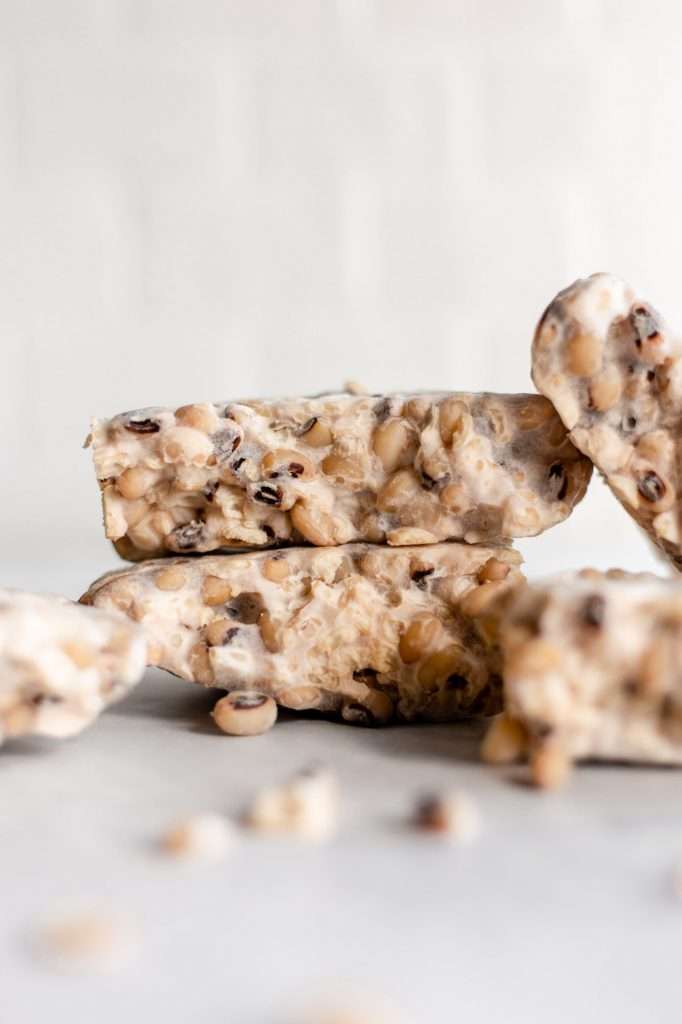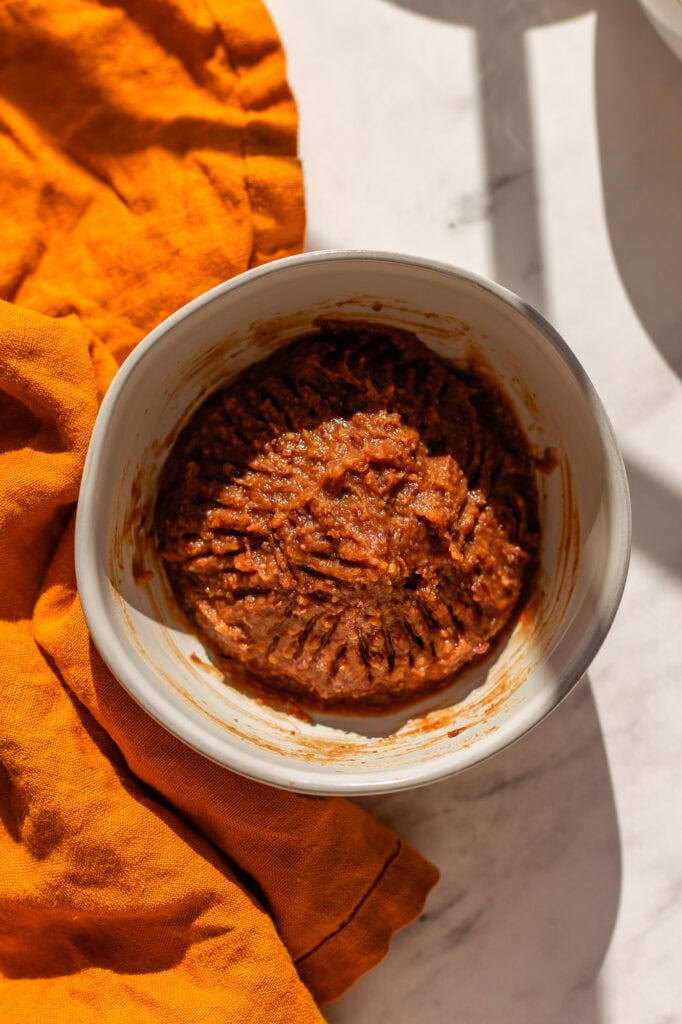The History of Tempeh
Learning how to make tempeh starts with understanding its roots. Tempeh originated in Java, Indonesia, as a tofu and soybean oil manufacturing byproduct. It’s essentially just tender cooked legumes bound together by a dense mycelium of white Rhizopus mold.
When food crafters press oils from nuts and seeds and liquids from soybeans, the resulting waste products are fibrous and dense seed, bean, and nut cakes that must be discarded.
This soybean waste is called okara. It’s speculated that the okara got contaminated with fungi used for soy sauce production. Accidentally inoculating okara waste with fungi brought about a protein-packed, fiber-rich food that is quite delicious… and economical.
So, accidently or not, if you love tempeh, you can thank Indonesia for this delicious food!

Why Tempeh is Great for Gut Health
Homemade tempeh isn’t exactly probiotic because we cook tempeh before eating it. You technically can eat some raw, but I do not recommend it, and it’s best to cook it. However, the fermentation process of tempeh is very beneficial for gut health.
Tempeh fermentation helps remove phytic acid from legumes, making them easier to digest. The elimination of phytic acid through the fermentation process also means that the legumes will cause less gas production in the gut (so yes, you will fart less haha).
I should note here that cooking also reduces phytic acid in beans. So beans don’t have to be fermented to be good for you.
Tempeh is great for people who want to eat more beans. Shifting the diet to more beans and legumes as protein sources can sometimes cause bloating and gas initially. However, these side effects are significantly less likely with tempeh since it is fermented.
The Rhizopus fungi that ferment the legumes into tempeh make nutrients and vitamins more readily available.
How to Make Tempeh at Home
Learning how to make tempeh starts with a fungus. Let’s talk a little bit about the fungus that makes tempeh! It’s called Rhizopus, and it’s pretty cool.
Rhizopus is a genus of filamentous fungi commonly found in nature, on food, and in association with animals. Rhizopus fungi are characterized by a branching mycelia composed of three types of hyphae: stolons, rhizoids, and usually unbranching sporangiophores. This complex mycelium holds tempeh together in a uniform, dense mass.
Multiple species of Rhizopus can be used to make tempeh, but the most common species used is R. oryzae. CLICK HERE for the starter culture I like to use.


How to Make Tempeh: Removing the Hulls
I like soaking my legumes for about 12 hours. After soaking, I put the legumes in a bowl of cold water. Then I rub them between my hands in the water until many of the hulls float to the top. The hulls are easily poured off.
You don’t have to remove every single hull; the tempeh will still come out fine, as long as you remove a lot of them and break apart the legumes a little. More hulls will come off when you cook the legumes, too.
When cooking, you want them to be tender but not mushy. The legumes should be firmer than if you were cooking them to eat right away. It’s important not to overcook.

How to Make Tempeh: Drying Out the Beans, Peas or Lentils for Tempeh
For your homemade tempeh to come out delicious and safe, you must dry the legumes you just cooked.
Please do NOT put them in a dehydrator or anything; you are not trying to dry them out that much. I like to spread the cooked legumes on a clean sheet pan lined with a clean towel and let them air dry for about 2-4 hours. Sometimes, I’ll use a blow drier and blow hot air under the towel holding the peas to speed up this process.
The cooked legumes have to be more on the dry side, and the material the tempeh is wrapped in has to be breathable (either with holes or made from a porous material).


Wrapping the Tempeh
When learning how to make tempeh, one of the most essential aspects is deciding how to wrap it. You must tightly wrap the cultured legume mixture in a bag or something similar to make tempeh.
Honestly, I HATE using plastic to make tempeh. I think the most problems arise when you use plastic because the plastic holds too much condensation and moisture. This leads to nasty results and undesirable microbial growth.
However, if you want to take a chance, you can use a plastic bag with holes poked in it. If you need to use a plastic bag, I suggest using plastic bulk section bags or produce bags from the store. I get great results using these because they’re more porous than a ziplock.
Banana Leaves work best since they are porous, and you can sometimes find these at the Asian market. Another option is bamboo leaves (my personal favorite). You can also use cheesecloth (but you’ll have to wrap it with a few layers and sterilize it somehow after).
You’ll also need something heavy, like a large cutting board or a textbook, to press the legume mixture into a dense cake.


How to Tell if Homemade Tempeh is Safe to Eat
The breathable material provides oxygen to the aerobic fungi and, in tandem with dryness, prevents anaerobic spoilage microorganisms, like Bacillus spp. and Clostridium spp. These are the worst contaminants that we need to worry about with tempeh. These contaminants usually result from too much heat and too much moisture.
When you smell it, you’ll know if the tempeh hasn’t fermented properly. Bad homemade tempeh is very hard to miss.

Can You Freeze Tempeh?
Yes, you can freeze homemade tempeh. Freezing tempeh is a great way to extend its shelf life while preserving its texture and flavor. Here are some tips for freezing homemade tempeh:
- Cool Down: Ensure the tempeh is completely cool before freezing. This helps to prevent ice crystal formation that can affect texture.
- Portioning: Consider cutting it into smaller portions if you have a large block of tempeh. This way, you can thaw only what you need for a particular meal.
- Wrapping: Wrap the tempeh tightly in cling film or place it in a freezer-safe bag. Removing as much air as possible helps to prevent freezer burn.
- Labeling: Label the packaging with the date of freezing. Properly stored, frozen tempeh can last for up to 6 months.
- Thawing: When ready to use the tempeh, thaw it in the refrigerator overnight. Avoid thawing at room temperature, which can lead to uneven thawing and potential bacterial growth.
- Cooking After Thawing: Once thawed, cook the tempeh normally. It’s generally not recommended to refreeze thawed tempeh, as this can affect its quality.
Freezing doesn’t significantly change the texture or taste of tempeh, making it a convenient option for meal prep and reducing waste.
How to Make Tempeh with a Piece of Raw Tempeh
While your tempeh is fresh and raw, you can use it as the starter culture in your next batch. This is similar to how you use yogurt to culture the next batch of yogurt. You simply take a piece of your existing raw tempeh and crumble it into small pieces and add it in the same way you add in a packet of starter culture.
If you would like to do this, you’ll need to start the next batch right away. Reserve a chunk of tempeh in the fridge and use it within 4 days to start the next batch.
Remember, the quality of your starter tempeh significantly impacts the new batch. Make sure the starter tempeh is fresh and free from any signs of spoilage or contamination. Additionally, maintaining proper sanitation and environmental conditions is crucial for successful fermentation and preventing unwanted microbial growth.
More Tempeh Recipes to Try
Print
How to Make Tempeh | Sprouted Lentil Tempeh Recipe
This blog includes everything you need to learn how to make tempeh at home. This blog contains a soy-free sprouted lentil tempeh recipe, but you can use any legume you want, including soybeans.
- Prep: 60 Minutes
- Cook: 15 minutes
- Total Time: 1 hour 15 minutes
Ingredients
- 2 Cups Lentils*
- 2 Tablespoons Rice Vinegar
- 1 Teaspoon Tempeh Starter
Instructions
- Soak the lentils in water for about 8- 12 hours.
- After soaking, rinse the lentils a few times, then place them in a colander. Leave the colander on top of a towel on the counter for 12 hours.
- After 12 hours, you should see small sprouts starting to form on the sides of the lentils. Add to a bowl of cold water. Rub the lentils in between your hands gently to remove some of the hulls.
- Fill a stock pot with water, enough that should cover the lentils (but don’t add them in yet). Bring the water to a boil, then add the lentils in. Immediately reduce to a simmer.
- Cook uncovered, for about 3 to 5 minutes. Check the lentils continuously to see when they’re just tender. You want them to be tender, but not as soft as canned beans. Using a slotted spoon, remove any hulls that float to the top while simmering.
- Drain the lentils in a colander and remove as many hulls as possible.
- Spread the cooked lentils out on a clean sheet pan. Put the sheet pan in the oven on the lowest possible temperature and cook until the lentils are dry to the touch but still tender. (Alternatively, lay out on a clean, lint-free kitchen cloth until dry to the touch.)
- In a clean mixing bowl, add the lentils, vinegar, and tempeh starter. Mix well.
- Place the mixture on clean leaves or in a plastic bag. If using a plastic bag, press all of the air out of the bag to create a tightly packed, rectangular mass. Poke holes in the bag all over, with a toothpick. If you use leaves, arrange the mixture into a rectangle on top of the leaves, then fold over the leaves to wrap it like a package around the mixture. It should be a tightly secured rectangular shape. Secure closed with twine.
- Place the wrapped tempeh mixture in a warm place for 12 hours. Ideally, tempeh should be at 85 to 91° F for 24 hours, then at 60-75° F for 24 more hours. ( I like to place something heavy on it, like a book, to get a denser bind).
- After 12 hours, the tempeh should be generating its own heat. This is part of the fermentation process. Remove it from the warm location and set it at room temperature for another 24-36 hours.
- Unwrap the tempeh, and you will have a few storage options:
- You can vacuum seal, boil, then store in the fridge or freezer. This is how you get store-bought level tempeh.
- You can refrigerate (cook and eat within 4 days)
- You can cook it immediately with seasoning, then refrigerate and eat within 7 days.
- or you can freeze it in an air-tight container.
Notes
- You can use any legume for this recipe. Simply skip the sprouting step to make regular tempeh with any type of bean or legume.
- If you find that your beans are still kind of wet after the drying period: toast some flour in the oven at 350 degrees for 15 minutes to sterilize it. add two small spoonfuls of the flour to the mixture to dry it out more.
- If you have an instant pot with a yogurt setting, you can set it to the low temperature for 91° F and place the tempeh on a rack in the instant pot for the first 24 hours, then move to room temperature for the last 24-48 hours.




















Hi! I just tried my first batch of tempeh with sprouted lentils. You’re right – cooking them is the hardest part. I soaked, rinsed, and sprouted the lentils successfully. I brought them to a boil in a pot and reduced heat to medium. After about 10 minutes I checked on them and was disappointed to find that half of them were already complete mush and the other half were intact but way too soft. Did I do something wrong?
Hey there, cooking legumes to the proper firmness can be complicated. Many different things could have happened. Your lentils may have been more sprouted than mine, so they cooked faster. I just adjusted the recipe instructions to cook uncovered and check the lentils every five minutes, instead of 10. Thank you for your feedback!
You might want to try steaming the lentils (or beans) instead of boiling them. It’s much easier to control the moisture content because they can’t continue absorbing water like they can if boiled. I use a bamboo steamer for this.
Hi there! Just wondering why you say the cheesecloth has to be discarded after?
Since we’re dealing with a fungus for this fermentation, removing the tempeh culture fungal spores from the cheesecloth is nearly impossible. Reusing the cheesecloth for other foods will cause contamination.
but either way its ‘contaminated’ with tempeh spores, which arent bad in itself.
does the tempeh fungi prefer an acidic, moist, anaerobic environment? love to nerdoptimize this stuff 8)
yes to the acidic condition, and no to the moist and anaerobic conditions.
The slightly acidic condition is provided by the addition of the rice vinegar. As stated in the body of this blog post, the cooked legumes have to be more on the dry side, and the material the tempeh is wrapped in has to be breathable (either with holes or made from a porous material) to provide oxygen to the aerobic fungi and prevent anaerobic spoilage microorganisms, like clostridium spp.
interesting, natto fungi seem to enjoy the same conditions. what’s your take on the tempeh recipes that mix in grains like rice or millet (mixed grain tempeh)? would the tempeh fungi be able to feed on the grains or would another fungi take care of it?
Natto is fermented predominately by bacteria. Not fungi. The “spores” used to innoculate natto are Bacillus subtilis endospores, which are bacteria, not fungi.
Rice and grains are great in tempeh. As stated in the blog, I suggest adding rice flour to the mixture to eliminate the excess moisture in the legumes before adding the tempeh culture. Rhizopus fungi are definitely able to metabolize grains in the same way they metabolize legumes.
nice, thank you. itd be awesome to see a natto post when u get the chance
hello – is it possible to eliminate the flour or use a different kind? i dont have rice flour on hand at the mment.
Hey! You can eliminate the rice flour, you just need to ensure that the beans are very dry to the touch before adding in the cultures. You can also sub the rice flour for chickpea flour.
Hi Kaitlynn
Thanks for such an awesome, detailed recipe. I have been making tempeh for a little over 3 months, mostly successfully. However, I am still looking for some tips, since I’ve always frozen half of my batches and it just so happened that when I leave a piece of tempeh to defrost in the fridge it quickly starts to create some black fungus. Any idea why this happens?
Take care,
Agus
Hi Kaitlynn,
Thank you for the very detailed recipe. I just put my bags of lentil in the oven for their 12 hour initial fermentation. I hope I dried the lentils enough. Crossing my fingers. One question, I noticed other recipes say to mix the vinegar in while cooking the beans or lentils. Have you found better results mixing vinegar at the end with the starter and rice flour. Oh, another question, I used brown rice flour. Is that ok? Is white rice flour better? Does is matter? Thank you! I’ll let you know how it turned out.
Glad you enjoyed the recipe! I never cook my beans with vinegar added, so I can’t really compare the results. Adding vinegar in while the beans cook can alter the cooking time. Brown rice flour should work out fine and the same as white rice flour. Hope your tempeh turned out!
Hi, Kaitlynn!
I’m on a low-FODMAP diet for SIBO, however I have found that soy tempeh is digestible. My question is if you have any information on the FODMAP levels of lentil tempeh and how comparable that is to the levels in soy tempeh? Thanks!
Hey there,
I’m sorry, I don’t have any exact nutritional analysis or analysis of fermentable saccharide levels in lentil tempeh. I know cooked lentils are considered low FODMAP, so I’d think that following this recipe, sprouting, cooking then fermenting the lentils into tempeh results in even lower in FODMAPs.
Hello! Thanks for this tutorial. I’m just getting started. I have a question about freezing the tempeh. You mention an added step of vacuum sealing and then boiling. Is that necessary for freezing? I’m hoping to make plastic-free tempeh but I would also like to freeze it to last longer. Thanks in advance for any clarification you may have here.
I would do the vacuum sealing if freezing it, to keep it fresher longer. But I’m sure you can just freeze it in a container with okay results.
Do you think any other flours would be acceptable? I’ve got: almond, tapioca, potato, gf blend, arrowroot, sprouted oat?
Thanks!! I’ve been looking for a sprouted tempeh recipe!!
Unsure. If you try it, you should toast the flour in the oven first to make sure it’s free of any unwanted microbes.
Hi, I’m wondering if you’ve had success using a piece of tempeh to start the next batch; thus only purchasing a starter once? Is that working and sustainable or do you buy starter often?
I tried it once and it worked well. I dehydrated a fresh piece of tempeh at a low temperature then ground it into a powder.